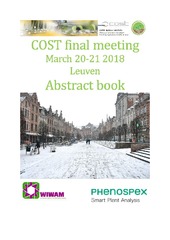Приказ основних података о документу
Comparative analysis of genetic diversity among cultivated wheat (Triticum aestivum L.) and its related species using microsatellite markers
| dc.creator | Kondić-Špika, Ankica | |
| dc.creator | Denčić, Srbislav | |
| dc.creator | Mikić, Sanja | |
| dc.creator | Trkulja, Dragana | |
| dc.creator | Marjanović-Jeromela, Ana | |
| dc.creator | Hristov, Nikola | |
| dc.date.accessioned | 2021-09-21T10:15:02Z | |
| dc.date.available | 2021-09-21T10:15:02Z | |
| dc.date.issued | 2018 | |
| dc.identifier.uri | http://fiver.ifvcns.rs/handle/123456789/2258 | |
| dc.description.abstract | One of the prerequisites for further improvement of wheat is the assessment of genetic variability of wild relatives, for t he identification of desirable traits that can be used for the genetic enhancement of elite material. The aim of this study was to analyse the polymorphism of 15 microsatellite loci in the collection comprising of 40 genotypes of bread wheat (Triticum aestivum L.), 32 genotypes belonging to other species within Triticum genus, and 3 genotypes from Aegilops genus. The results showed high level of genetic diversity present in the collections of cultivated wheat and its relatives. In the collection of bread wheat genotypes, 119 alleles were detected, while in related species 157 alleles were identified. The average gene diversity of 0.68 and 0.81 were found in cultivated wheat and relatives, respectively. The average PIC value in bread wheat was 0.65, and in related species was 0.79. Different dominant alleles were identified in the collections of bread wheat and related species at 9 out of 15 examined loci. Higher number of alleles in the collection of related species was found at 10 loci, while at three loci ( Xbarc 12, Xgwm284 and Xwmc457) higher number of alleles was found in bread wheat genotypes. The two loci (Xgwm495 and Xgwm3) had the same number of alleles in both groups of genotypes. Analyses of individual genomes indicated that only the A genome had simi lar genetic variability indicators in the both groups of genotypes, while genetic diversities of the B and D genomes in the cultivated wheat were significantly reduced in relation to the other species. All analysed parameters of genetic diversity showed significantly higher level of polymorphism present in the wild relatives than in the cultivated bread wheat, indicating a huge potential of using wild related species as a source of new genetic variability for further improvement of agronomicaly important traits in bread wheat. | sr |
| dc.language.iso | en | sr |
| dc.publisher | Brussels : COST Association | sr |
| dc.relation | COST Action FA1306: The quest for tolerant varieties - Phenotyping at plant and cellular level (STSM) | sr |
| dc.rights | openAccess | sr |
| dc.rights.uri | https://creativecommons.org/licenses/by/4.0/ | |
| dc.source | Book of Abstracts, COST FA1306 Meeting 2018: "Plant phenotyping for future climate challenges", 20-21 March 2018, Leuven, Belgium | sr |
| dc.subject | Triticum aestivum L. | sr |
| dc.subject | wheat | sr |
| dc.subject | genetic diversity | sr |
| dc.subject | microsatellite markers | sr |
| dc.subject | wild relatives | sr |
| dc.subject | polymorphism | sr |
| dc.title | Comparative analysis of genetic diversity among cultivated wheat (Triticum aestivum L.) and its related species using microsatellite markers | sr |
| dc.type | conferenceObject | sr |
| dc.rights.license | BY | sr |
| dc.citation.epage | 62 | |
| dc.citation.spage | 62 | |
| dc.identifier.fulltext | http://fiver.ifvcns.rs/bitstream/id/6020/bitstream_6020.pdf | |
| dc.identifier.rcub | https://hdl.handle.net/21.15107/rcub_fiver_2258 | |
| dc.type.version | publishedVersion | sr |


